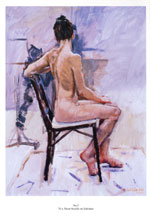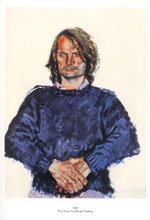New Works by Mick O'Dea (2001)
This recent exhibition of new works consists of a series of portraits and studio studies. They were created during the course of the past year here in Ireland and the USA. The subjects depicted are varied. They include art students, artists, his daughters, his mother and colleagues from the Lime Academy in New England, where he visited as part of a teaching exchange programme with the National College of Art and Design.
O'Dea is an artist with a vivid awareness of the roots of his painterly tradition. He sees himself as being located within the scope of the Northern Renaissance, having particular leanings towards the Austrian school. Auerbach and Schiele have been suggested as antecedent influences with Kokoschka as a close third. This is not meant to be reductive in any sense, for his ready individuality finds a more than assertive voice with frequent and consummate ease . He would also acknowledge his indebtedness to a tradition which owed its main expressive force to Orpen and the Dublin Metropolitan School. Keating readily comes to mind as do the resonances of Carey Clarke , John Kelly senior and latterly Charles Cullen. Thus the process becomes one of reinforcing certain shared attributes, which are the hallmark of excellence and authenticity. As he expresses it, both verbally and visually, he cannot abide the sins of Irrelevance, Sentimentality and Romanticism. He displayed this contempt for lazy naturalism in his previous exhibition in 1999 a collaboration with Édaín O'Donnell when he demonstrated a fluid sense of urgency in markmaking allied to a rigorous exposition of the psychological dynamics of working with a model.
These themes are continued here with equal force and vivacity. He distinguishes quite clearly between what he describes as corporate and private portraiture. In the corporate sense the ostensible purpose may be to both affirm and confirm the status of the subject. History is littered with too many examples of this genre. The subject is surrounded by the sensible or outward signs of station and perceived substance. The inherent paradox of much of this type of portraiture lies in the fact that while it purports to be revelatory it relies on devices of concealment for its potency and credibility. Private portraiture however is manifestly revelatory with no additional covert agenda to explore other than a discreet, but understandable, celebration of virtuosity here and there.
O'Dea is a natural observer. He recalls early childhood experiences in his father's pub in County Clare, looking at and listening to the people who came there, playing with toy soldiers, engaging with old table top generals, listening to stories, weighing up the clientele, the bar counter always to hand as a ready, convenient distancing and framing device. Later as a young student at NCAD he worked as an artist's model- an invaluable experience which gave him further insights into the dynamics of observation. He had learned early on, almost intuitively, the value of complicity, mutuality, the willing and encouraged acceptance of the engagement with others. This goes to the core of his belief in authenticity. For the portrait to have this value it should be a bilateral effort a synergy between artist and subject. To this end he invariably selects whom he wishes to paint, preferring to involve creative people as subjects. He believes that they have an automatic sympathy with the process in that they easily relinquish defence mechanisms and thus manage to reduce the degree of psychological 'noise' in the interaction. This is his main objective in these works.
He aims to reflect the clarity of vision he had, the extent to which he was able to clear the field and fairly adjudicate the vibrations emanating from his subject at a particular moment. This is his touchstone for authenticity, and relevance. In some of these portraits the background is eliminated. He has dispensed with props and allows theinterplay of the subject with the whiteground negative space. This gives the focus an effect of starkness and freshness, which is dependent on an assured and determined compositional structure. As a bonus we note that while the application of paint may be traditional the sensibilities emanating from the subjects are essentially contemporary.
The figurative studio studies which were created in the Lyme Academy of Fine Art reveal O'Dea as truly in touch with his metier. One senses that in the life room he is in a sympathetic environment which is both challenging and comforting at the same time. The studies are immediate and forceful, painted as they are, without preamble or preparatory drawing. He continues to explore form, colour, tonality and composition but never objectifies his subject. The humanistic element remains firmly grounded, and rooted within his tradition. The defensiveness about Academicism is absent from these works as is the sense of having to re-assert an apologia for Traditional values.
In the recent past these terms were used pejoratively. He has a realistic understanding of why this was so. In the art schools of the 70s and 80s the Academic tradition was perceived to have been critically lazy, and totally reliant on the optics at the expense of the mind. It appeared to create and justify an intellectual deficit. True enquiry it was believed could only be conceptually based. In addition, and this view still lingers, there was a reluctance on the part of those who forsook an Academic approach to come to terms with the old enemy. Figurative work was associated with the Establishment and was anti-minority. It was white male, not female and not gay. He believes that the tradition of European figure painting is strong and will emphatically endure. Painters will always paint. For O'Dea this is a path of enquiry he needs to engage in to feel that he is engaging with life itself.
Gerry Walker
Garryhoe,
2001.

